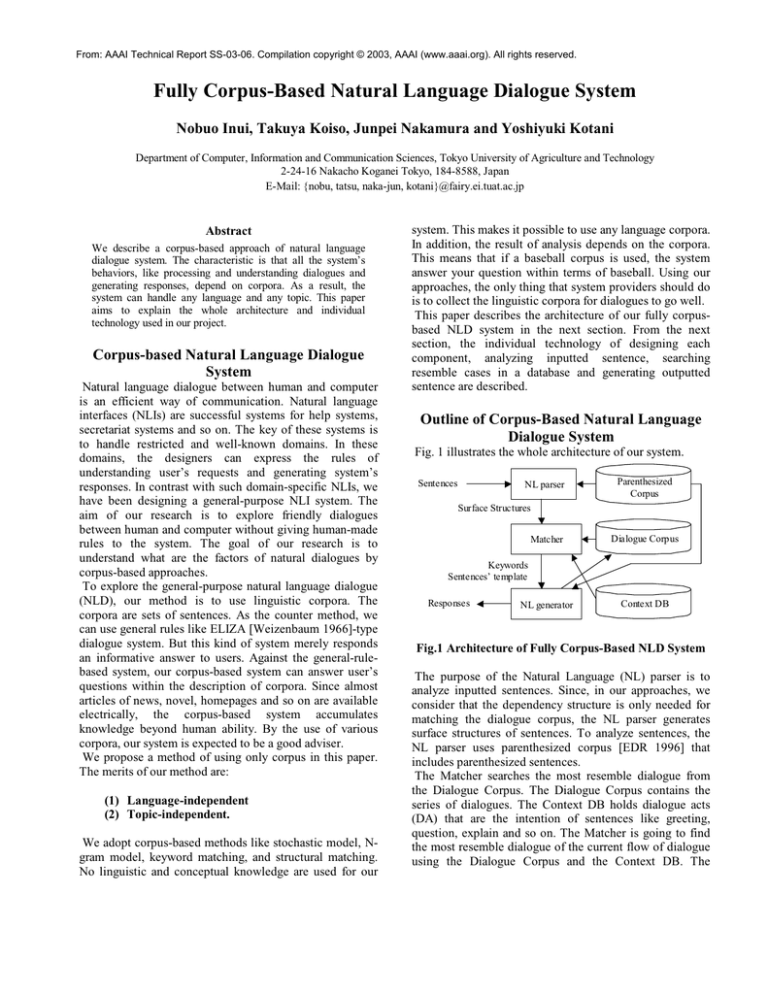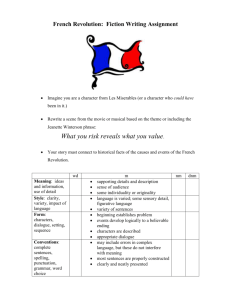
From: AAAI Technical Report SS-03-06. Compilation copyright © 2003, AAAI (www.aaai.org). All rights reserved.
Fully Corpus-Based Natural Language Dialogue System
Nobuo Inui, Takuya Koiso, Junpei Nakamura and Yoshiyuki Kotani
Department of Computer, Information and Communication Sciences, Tokyo University of Agriculture and Technology
2-24-16 Nakacho Koganei Tokyo, 184-8588, Japan
E-Mail: {nobu, tatsu, naka-jun, kotani}@fairy.ei.tuat.ac.jp
Abstract
We describe a corpus-based approach of natural language
dialogue system. The characteristic is that all the system’s
behaviors, like processing and understanding dialogues and
generating responses, depend on corpora. As a result, the
system can handle any language and any topic. This paper
aims to explain the whole architecture and individual
technology used in our project.
Corpus-based Natural Language Dialogue
System
Natural language dialogue between human and computer
is an efficient way of communication. Natural language
interfaces (NLIs) are successful systems for help systems,
secretariat systems and so on. The key of these systems is
to handle restricted and well-known domains. In these
domains, the designers can express the rules of
understanding user’s requests and generating system’s
responses. In contrast with such domain-specific NLIs, we
have been designing a general-purpose NLI system. The
aim of our research is to explore friendly dialogues
between human and computer without giving human-made
rules to the system. The goal of our research is to
understand what are the factors of natural dialogues by
corpus-based approaches.
To explore the general-purpose natural language dialogue
(NLD), our method is to use linguistic corpora. The
corpora are sets of sentences. As the counter method, we
can use general rules like ELIZA [Weizenbaum 1966]-type
dialogue system. But this kind of system merely responds
an informative answer to users. Against the general-rulebased system, our corpus-based system can answer user’s
questions within the description of corpora. Since almost
articles of news, novel, homepages and so on are available
electrically, the corpus-based system accumulates
knowledge beyond human ability. By the use of various
corpora, our system is expected to be a good adviser.
We propose a method of using only corpus in this paper.
The merits of our method are:
(1) Language-independent
(2) Topic-independent.
We adopt corpus-based methods like stochastic model, Ngram model, keyword matching, and structural matching.
No linguistic and conceptual knowledge are used for our
system. This makes it possible to use any language corpora.
In addition, the result of analysis depends on the corpora.
This means that if a baseball corpus is used, the system
answer your question within terms of baseball. Using our
approaches, the only thing that system providers should do
is to collect the linguistic corpora for dialogues to go well.
This paper describes the architecture of our fully corpusbased NLD system in the next section. From the next
section, the individual technology of designing each
component, analyzing inputted sentence, searching
resemble cases in a database and generating outputted
sentence are described.
Outline of Corpus-Based Natural Language
Dialogue System
Fig. 1 illustrates the whole architecture of our system.
Sentences
NL parser
Parenthesized
Corpus
Surface Structures
Matcher
Dialogue Corpus
NL generator
Context DB
Keywords
Sentences’ template
Responses
Fig.1 Architecture of Fully Corpus-Based NLD System
The purpose of the Natural Language (NL) parser is to
analyze inputted sentences. Since, in our approaches, we
consider that the dependency structure is only needed for
matching the dialogue corpus, the NL parser generates
surface structures of sentences. To analyze sentences, the
NL parser uses parenthesized corpus [EDR 1996] that
includes parenthesized sentences.
The Matcher searches the most resemble dialogue from
the Dialogue Corpus. The Dialogue Corpus contains the
series of dialogues. The Context DB holds dialogue acts
(DA) that are the intention of sentences like greeting,
question, explain and so on. The Matcher is going to find
the most resemble dialogue of the current flow of dialogue
using the Dialogue Corpus and the Context DB. The
Matcher generates keywords along with the current
dialogue and sentences’ templates to make responses.
The NL generator generates the system’s responses. The
role of the NL generator is to determine the exchanges of
keywords and words in sentences’ templates. The system
designer gives the exchange strategy because it decides the
character of the system. The structures and the word orders
of responses are determined using the parenthesized corpus
and replacing words simply. The inputted sentences and
the responses are stored to the Dialogue Corpus to re-use
for the future dialogue.
Since it is possible for a user to input ungrammatical
sentences, the NL parser is required to parse any sentences
robustly. For this reason, we use the N-gram-based shallow
parser [Inui 2002a][Inui 2001] shown in Fig. 2. A large
parenthesized corpus is easily available.
Pattern-Based
Segmentation
Phrase-Pattern
Extractor
parenthesized
structure of words
Clause
Structural Matcher
Dialogue Act Analyzer
pairs of keywords
a sequence of dialogue act s
Similarity Searcher
Dialogue
Corpus
Context-DB
Parenthesized
Corpus
a pair of inputted sent ences
and a matched case
N-gram DB
N-gram-Pattern
Extractor
Fig.2 The Architecture of NL Parser
The characteristic of this parser is that no ready-made
syntactic rules like context-free based rules [Charniak
1997] are required. The Phrase-Pattern Extractor generates
the Phrase DB and N-gram-Pattern Extractor generates the
N-gram DB from the parenthesized corpus. To parse
sentences robustly, the N-gram-Based Segmentation is
designed. In both of segmentation modules, a clause
boundary marker (@, described later) is introduced as a
special word. The Pattern-Based Segmentation module
simply divides a sequence of words (sometimes characters)
into a sequence of clauses, based on the frequency of
clause (for example, ((I) (went to Palo Alto))). If the parser
fails to find the pattern, the sequence of words is handed to
the N-gram-Based Segmentation module.
The N-gram-Based Segmentation module tries to parse a
sequence of words by N-gram DB which contains N-gram
rules like, for example in case of bi-gram, ‘I @’, ‘@ went’,
‘went to’ and so on. The N-gram-Based Segmentation
module uses the conditional probability to forecast
positions of clause boundary markers so as to maximize the
expression (1).
(1) P( w1 L wn ) = P ( w1 ) P (w2 | w1 ) L P( wn | w1 L wn−1 )
≈ P (w1 ) P( w2 | w1 ) L P ( wn | wn − k +1 L wn −1 )
P ( w j − k +1 L wn ) =
Keyword Selector
Phrase DB
Clause
Ngram-Based
Segmentation
Matcher
The aim of the Matcher is to find the most resemble
dialogue for the current dialogue from the Dialogue Corpus.
We designed two kinds of implementation for the Matcher,
key words matching with dialogue acts and structural
matching. The architecture of the Matcher is shown in Fig.
3.
Surface Structure
Natural Language Parser
sequences of words
or character
structures like ((I)((went) ((to)(Palo) (Alto))))) are
generated in the NL parser by only using the parenthesized
corpus.
freq( w j −k +1 L wn )
total frequency
We use the linear interpolation expression of the
expression (1) for the robust parsing. Finally, surface
Fig.3 The architecture of the Matcher
In the keyword-based matcher, nouns and verbs are
considered to express the essence of sentences. But it is
difficult to find thematic noun and verb without knowledge.
To cope with this issue, the Similarity Searcher determines
the best noun and verb among all combinations of nouns
and verbs from the Dialogue Corpus (DC). In addition, to
express the flow of dialogue, we use a sequence of
dialogue acts [Reithinger 1997]. For example, YES/NOtype sentences often appear after QUSTION-type sentences.
Such knowledge is collected from DC. We use the
stochastic estimation of dialogue acts [Inui 2001b] in the
Dialogue Act Analyzer. Finally, the Similarity Searcher
finds the most resemble dialogue (i.e. including the same
keywords and the dialogue acts) from DC. For example, the
Similarity Searcher searches sentences in DC with “Palo
Alto” and “went” as keywords and “explain fact” as a
dialogue act.
The Structural Matcher [Koiso 2002] is another way to
find the most resemble case. In this case, the similarity is
calculated using the structural distance between two
sentences. Such structural information is considered to
include keywords and dialogue acts. In our current
implementation, a user selects a matcher before he uses our
system.
In both cases, the next sentences of the most resemble
sentences becomes candidates of the responses by the
system. For example, consider a sequence of dialogue, A, B,
C, D and the most resemble sentence of the current
inputted sentence is B. A sentence C becomes a candidate
of sentence template of the response. C would be used for
the next response.
It is also possible to find an appropriate dialogue by
looking up the n-past sentences. For example, the Matcher
tries to make a correspondence with a sequence of
sentences A, B and C. If C is not appropriate for the
current dialogue, we can find a sentence D as a candidate
of the next utterance.
It is possible to include picture character like ;-<, :-) and
so on. By using picture characters, a user feels friendly to
use the dialogue system [Nakamura 2002]. We consider
that this kind of response is important to continue
dialogues for human.
Natural Language Generator
The aim of the Natural Language generator is to generate
responses to a user. Fig. 4 illustrates the architecture.
Keywords
Sentence Temp late
Keyword
Corresponder
Parenthesized
Corpus
Exchange Rules
Dialogue
Corpus
Response
Structural
Transformer
Response
NL parser
Fig. 4 The architecture of the NL generator
The Keyword Corresponder makes the correspondence
between keywords in inputted sentences and the word in
sentence templates. For example, when “I went to Palo
Alto” is matched to “He went to Africa”, the keyword
corresponder makes rules like exchanging ‘He’ to ‘I’ and
exchanging ‘Africa’ to ‘Palo Alto’. This is made by the
structural positions of words in sentences.
The Structural Transformer generates several candidates of
responses using exchange rules. The NL parser described
in the section 3 determines which sentence is preferable.
The NL parser outputs the structure and the occurrence
probability of a sentence. The Structural Transformer
selects the preferable response with the maximum
occurrence probability. This guarantees the grammatical
correctness of the response.
Finally, the response is given to user as the system’s
utterance and the current dialogue is stored to the Dialogue
Corpus. The current dialogue would be re-used for the
future dialogue. In this manner, the system can grow the
Dialogue Corpus automatically.
Summary of Example Dialogue
We demonstrate an example of dialogue explained above.
User: I went to Palo Alto
NL parser: ((I) (went (to (Palo Alto))))
I: noun, went: verb: to: prep., Palo Alto:noun
Matcher: He went to Africa, How did he go there?
NL generator: How did I go there?
System: How did I go there?
In this case, ‘I’ should be re-rewritten to ‘you’ in the
system’s utterance. Our method cannot do this, because
none of knowledge about person is acquired. But we can
improve our system’s response by collecting enough
dialogues.
Conclusion
We described our fully corpus-based natural language
dialogue system in this paper. We are carrying the
evaluation of our system out. The merit of our method is
that we can tune the system behavior to our favorite one by
changing corpora. We are interested in connecting a voicerecognition system and a voice-generating system to our
dialogue system. We consider our method as a tool for
exploring the naturalness and the friendliness of dialogue
for human.
Acknowledgement
This research was supported by the grant in aid No.
14580409, Japanese Ministry of Education, Culture, Sports,
Science and Technology
References
[Charniak 1997] Charniak E. 1997. Statistical Parsing
with a Context-free Grammar and Word Statistics. Proc.
AAAI 97. pp.598-603.
[EDR 1996] EDR. 1996. EDR Electric Dictionary Manual
Ver. 1.5.
[Koiso 2002] Koiso T., Ikeda T., Inui N., and Kotani Y.
2002. A dialog system which chooses a response using
similarity between a surface case rule patterns. IPSJ
conference. 1M-03.
[Inui 2001a] Inui N. and Kotani Y. 2001. Robust N-gram
Based Syntactic Analysis Using Segmentation Words. 15th
PACLIC. pp.333-343.
[Inui 2001b] Inui N., Ebe T., Indurkhya B., and Kotani Y.
2001. A Case-Based Natural Language Dialogue System
Using Dialogue Acts. IEEE International Conference on
Systems, Man and Cybernetics. pp.193-198.
[Inui 2002] Inui N. and Kotani Y. 2002. Using Patterns
for Syntactic Parsing. IASTED International Conference
Artificial Intelligence and Appications. pp.522-527.
[Nakamura 2002] Nakamura J., Ebe T., Ikeda T. Inui N. and
Kotani Y. 2002. A method of outputting FACEMARK
suitable for the response sentence of natural dialogue
system using emotions model and DIALOGUE ACT. IPSJ
Conference. 1M-04.
[Reithinger 1997] Reithinger N. and Klesen M. 1997.
Dialogue Act Classification Using Language Models.
EuroSpeech-97. pp.2235-2238.
[Weizenbaum 1966] Weizenbaum J. 1966. ELIZA- A
Computer Program for the Study of Natural Language
Communications between Men and Machines. CACM. Vol.
9. pp.3-45.






